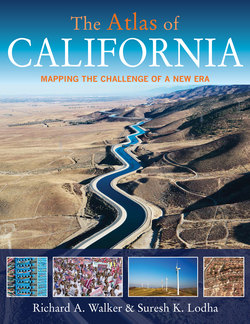Читать книгу The Atlas of California - Suresh K. Lodha - Страница 21
На сайте Литреса книга снята с продажи.
ОглавлениеColonialism & Native Californians
Native Californians arrived more than 10,000 years ago. They lived in families and clans of exceptional diversity, speaking 100 languages and 300 dialects. They prospered on the abundant wildlife, which they managed through seed collection, land-clearing fires, and fish ponds. Their numbers reached perhaps 300,000 in pre-Colonial times, the largest concentration north of the Valley of Mexico, but unlike the Iroquois they did not form nations. The Spaniards reached California in 1542, but left it alone until their empire was threatened in the late 18th century by British, French, Russian, and American expansion. The Christianizing Missions founded by Father Junipero Serra, where natives were forced to live and work, brought devastation through disease and destruction of past ways of life. Native numbers fell by one-third to one-half, especially along the coast. The Mexican era after 1821 brought new trials to people further inland and northward. Mexican rancheros exploited the natives as indentured labor, while building a trade in hides and tallow. Again, thousands of the natives perished. The Mexican–American war in 1844–46 brought California under the sway of the US, which annexed the northern half of Mexico in 1848. Following this, the Gold Rush drew in some 300,000 fortune seekers. Miners overran the last mountain redoubts of the native peoples, and many were enslaved. Nowhere were American Indians treated worse. The first governor, Peter Burnett, called for the extermination of native tribes, a task aided and abetted by state militias. California opposed Indian Reservations and federal agents were notoriously corrupt, leaving most native people landless and scattered. There are over 100 recognized tribes in California, but most bands never reclaimed lands other than tiny rancherias. The population of Native Americans fell to a low of 15,000 by 1900, then started a slow recovery, often through mixing with the conquering people. Estimates depend on the criteria for inclusion, but have increased rapidly since 1950. Before that, many did not want to identify as a disparaged people; but with the rebellions of the 1960s native heritage became a source of pride, swelling the census count. In addition, Native Californians migrated to the cities, where they were joined by tens of thousands of American Indians from around the west, forced from reservations by poverty and the federal decertification of tribes. By 1970 they were outnumbered by new migrants, and numbers were climbing fast. The urbanization and mixing of tribes gave rise to the American Indian Movement, ignited when young militants seized Alcatraz in 1969 and proclaimed it liberated territory. Today, there is a renewed pride in learning native languages, crafts, and culture. The legalization of native-run casinos, over 60 in 2011, has earned more than $7 billion. The income has been used to improve housing, restore tribal lands, and improve education, but has led to disputes over tribal membership. After 200 years of oppression, Native Americans are still struggling to preserve their identities and culture and finding it an uphill task to attain the same level of education, health, and liberties as other minorities do.
California was part of the Spanish Empire, then Mexico, before being annexed to the United States. Native peoples were annihilated by Spaniards, Mexicans, and Americans alike, through forced removal, slave labor, disease and massacres, and are still struggling to regain their rightful place in state life.
22
